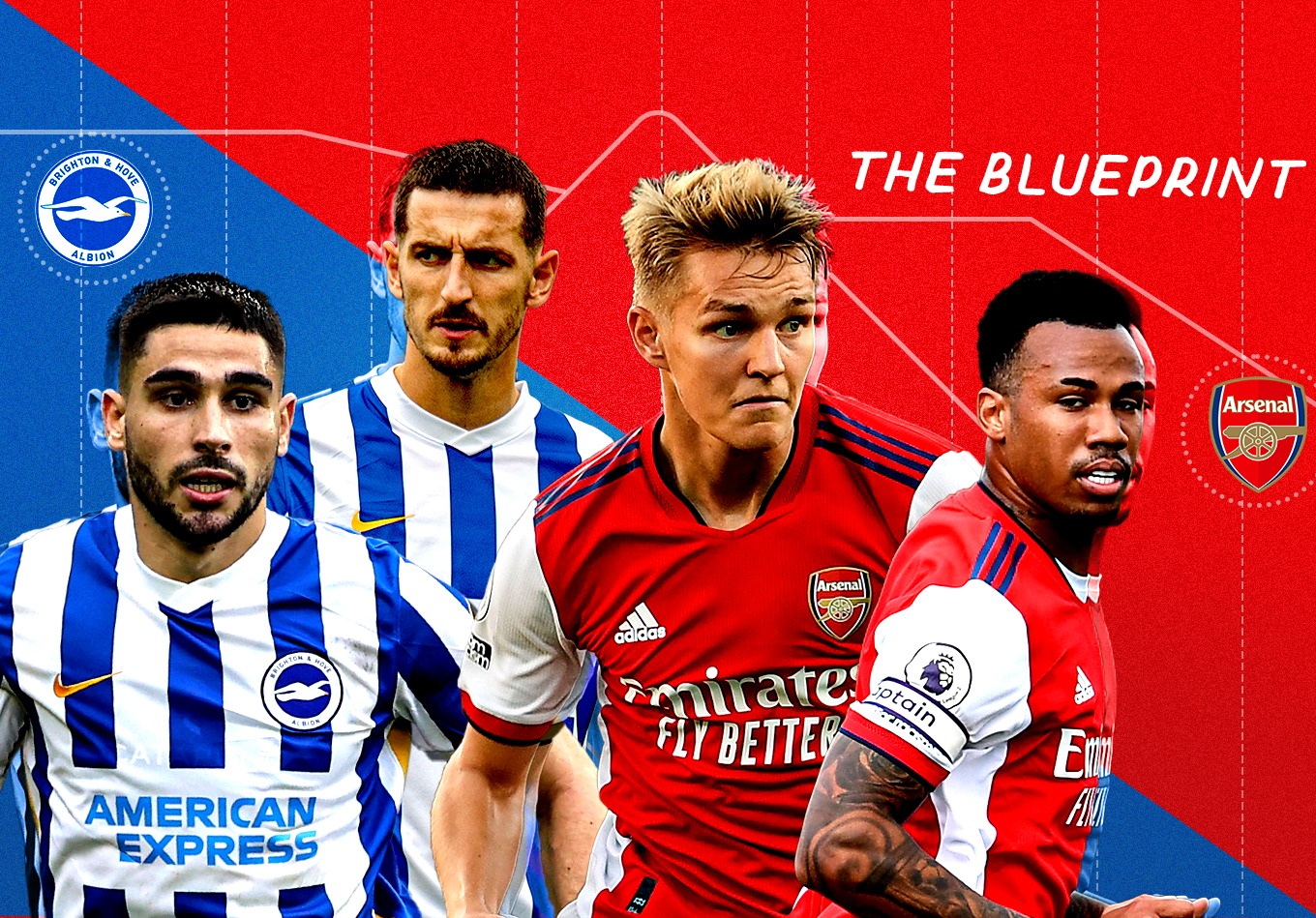Although Monday night saw Brighton miss out on the chance to go top of the top-flight for the first time in their history, The Seagulls have still enjoyed a fantastic start to this year’s Premier League. Their current league position of sixth is great in and of itself, but when you realise they’re actually joint-second on 13 points with five other clubs, it tells you how impressive they’ve been. It also points to a juicily competitive title race and top four battle this year, but that’s a story for a different day.
Albion welcome Arsenal this weekend. Mikel Arteta’s side are flying high after a resounding derby win over neighbours Tottenham, and they’ve now won three on the bounce. To illustrate their reversal of fortunes, The Gunners are just the third side in Premier League history to lose their opening three games of a campaign and then win their next three, after Wimbledon in 1996-97 and West Bromwich Albion 2002-03. The Dons won their seventh game in that campaign, while the Baggies lost theirs. Arsenal’s fate? Well, we’ll see.
Our win probability model puts Arsenal as favourites for this one at 43.3%, something which will no doubt rankle Brighton fans, but they’re not strong favourites by any means.
Where could this intriguing matchup be won and lost? Here are five tactical trends to help you decide:
1. Brighton Are So Hot Right Now
It’s no secret that Brighton felt the wrath of the expected goals Gods last season. Graham Potter’s side’s underlying performances were a lot better than the actual results they saw on the pitch. Their 16th-placed finish came courtesy of a dangerous combination of wasteful finishing and extreme bad luck.
Such was their tumultuous relationship with the xG metric that “doing a Brighton” became common vernacular for a team’s inability to close out games, as well as the club being memed across social media for dominating matches but still somehow managing to drop points. One Brighton fan site even launched a petition demanding the 2020-21 Premier League season be decided on expected goals rather than real ones.
Even traditional broadcasters got in on the fun.
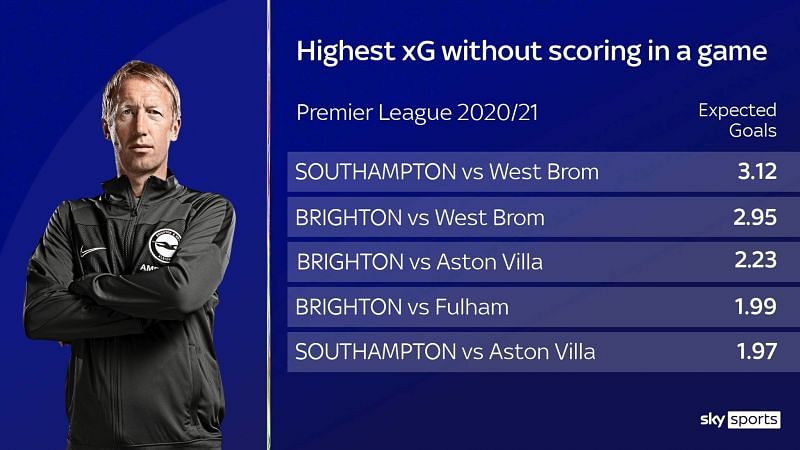
The numbers don’t make pretty reading.
Brighton amassed a non-penalty xG total of 44.6 last season (the 11th most in the league) but scored a paltry 34 non-penalty goals from that. Their underperformance in front of goal of over 10 goals was the third-worst in the division, behind Fulham and Sheffield United. I wonder what happened to them that year…
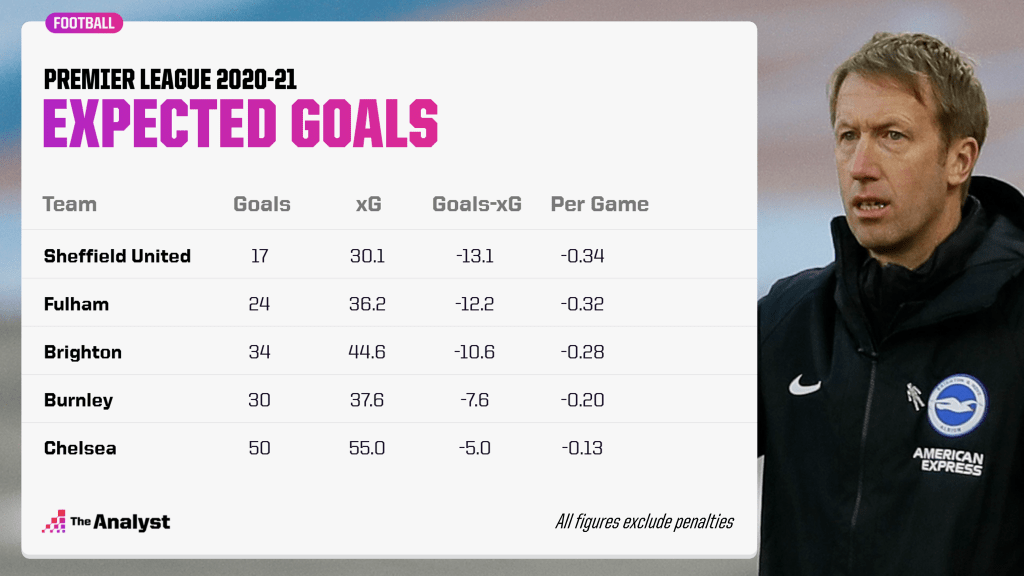
On average each game, Brighton were leaving almost a third of a goal on the table.
Plainly, The Seagulls created lots of chances but wasted them. Their shot conversion rate was way down at 8.2% (17th worst in the league), as was their Big Chance conversion rate (32.3%, also 17th worst.) Big Chances are essentially a proxy for “he’s got to score that!” opportunities.
They could have and should have, scored a lot more. Chief among the guilty parties was striker Neal Maupay, who registered 10.3 non-penalty xG in 2020-21 (pretty good) but scored just five goals from that (pretty bad). That underperformance saw him rank third-highest in the league behind Timo Werner (of course), and Jamie Vardy.
But what a difference a new season makes. The chances that were missing last year are now going in.
Brighton are overperforming their expected goals numbers (7 goals from 5.8 non-pen xG) and Maupay has a 100% conversion rate on Big Chances. The world’s gone mad.
Maupay’s form in front of goal has helped Brighton’s Big Chance conversion rate leap from 17th worst to third best.
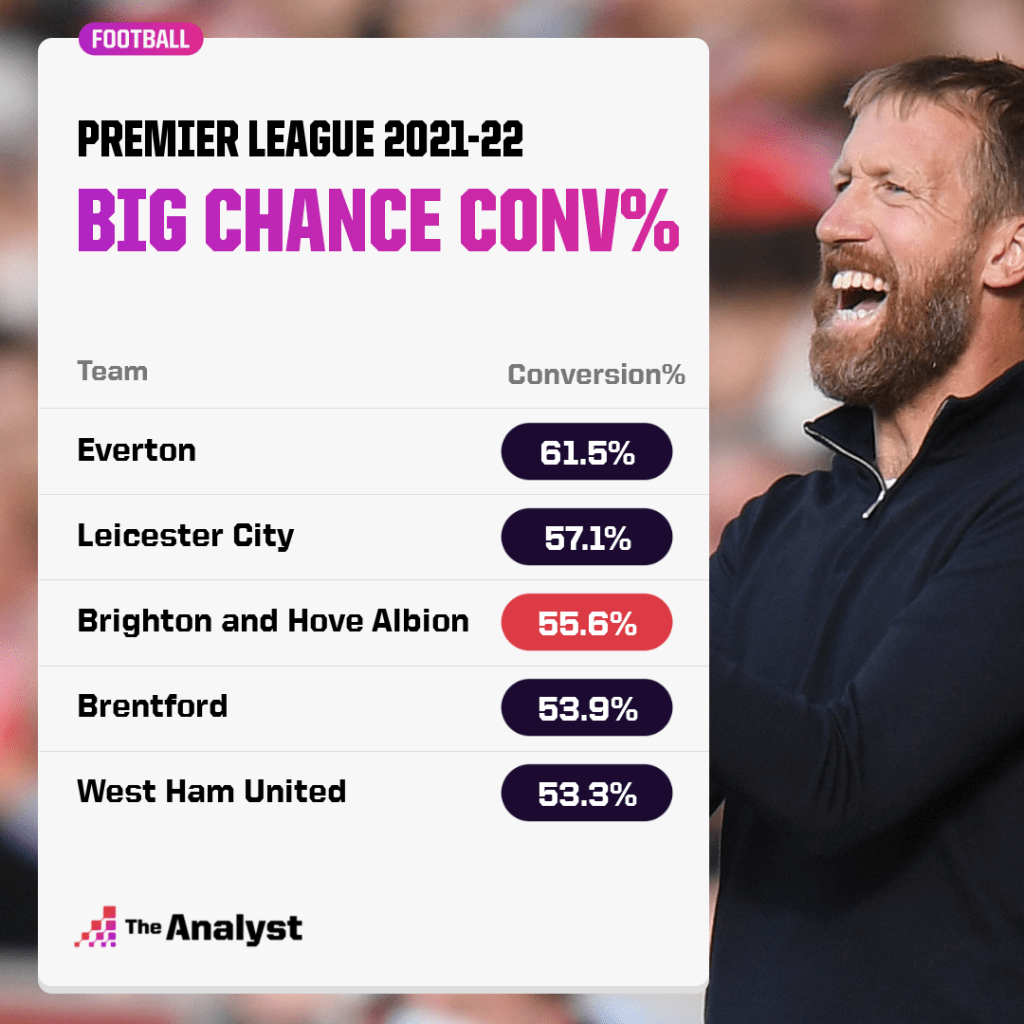
Ok fine, this point is less of a tactical trend and more of an intangible one but Brighton seem to be sick of the stick. For whatever reason: call it luck, player confidence, or regression to the mean, no longer can you bank on Brighton squandering good opportunities against you.
This team is clutch. Just take their equaliser against Crystal Palace on Monday night: At 94 minutes and 26 seconds, it was Brighton’s joint-second latest-ever Premier League goal.
Their league position reflects it. It’s funny how scoring goals rather than missing them can turn around a football team’s fortunes.
2. Brighton a Real Danger From Set-Pieces
Brighton are also a real danger from set-pieces, particularly from corners. With the 6-foot-3 pairing of Lewis Dunk and Shane Duffy, that may not come as a massive surprise, but we can quantify what our eyes are telling us.
The Seagulls are selective about their corner delivery. They go short often – 23% of the time in fact – which is the third-highest rate in the league. But when they do deliver the ball straight into the box, they make it count. Their corners into the box find a Brighton player 58% of the time – no team in the league has a better success rate – and in total, they’ve created 10 chances from corners this season, with only Liverpool (12) creating more. And if we standardise for the number of corners, then just shy of a third of Brighton’s corners are resulting in chances, which is the highest rate in the league.
Brighton are a threat, that much is clear. But how?
They don’t exactly pack the box, with an average of five players in the area for each corner (that’s about league average), but what this does allow is lots of space for The Big Lads™ to burst into.
Here’s a typical set-up for Brighton at a corner. The two target men, Dunk and Duffy, bunch together around the penalty spot in a sort of mini version of the ‘Love Train’ that Gareth Southgate’s England side used to good effect in World Cup 2018.
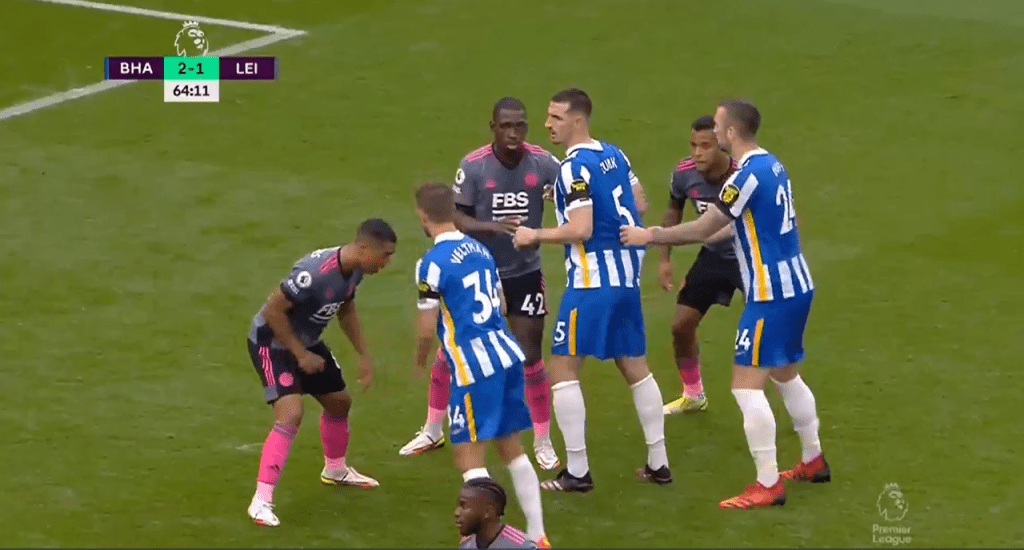
We also occasionally see a third player, Joël Veltman in this case, get involved. The Dutchman is currently being marked by Youri Tielemans.
But as the ball is kicked, Veltman pushes into Dunk’s marker Boubakary Soumaré, while Dunk runs to the near post, in front of Tielemans.
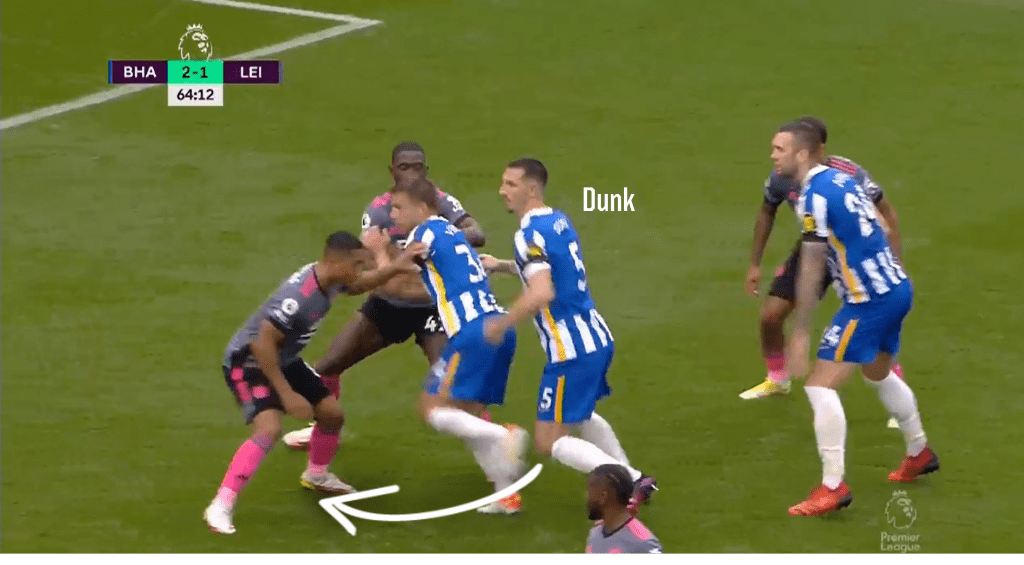
This essentially forces the two Leicester defenders to ‘switch’ who they are marking. They do this pretty seamlessly which is all well and good until you realise we’ve now got a giant height mismatch between Dunk and Tielemans.
And back to the space we referenced earlier. By not crowding the box, Brighton give their target men space to run into.
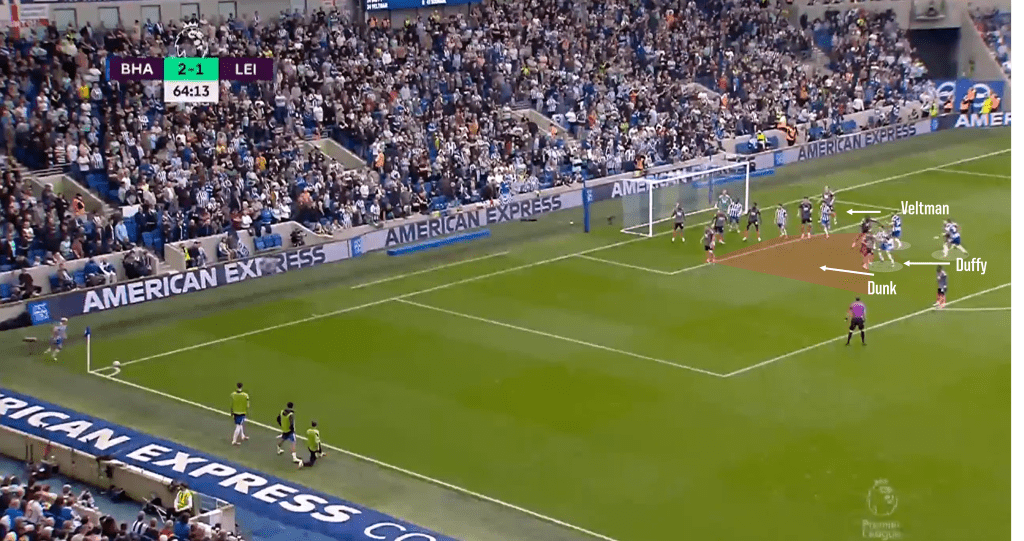
We saw the same set-up against Brentford a week before. Dunk and Duffy in the mini love train and another giant, Jakub Moder, also in attendance. Spot the lovely yawning space in a dangerous area for the ball to be whipped into.
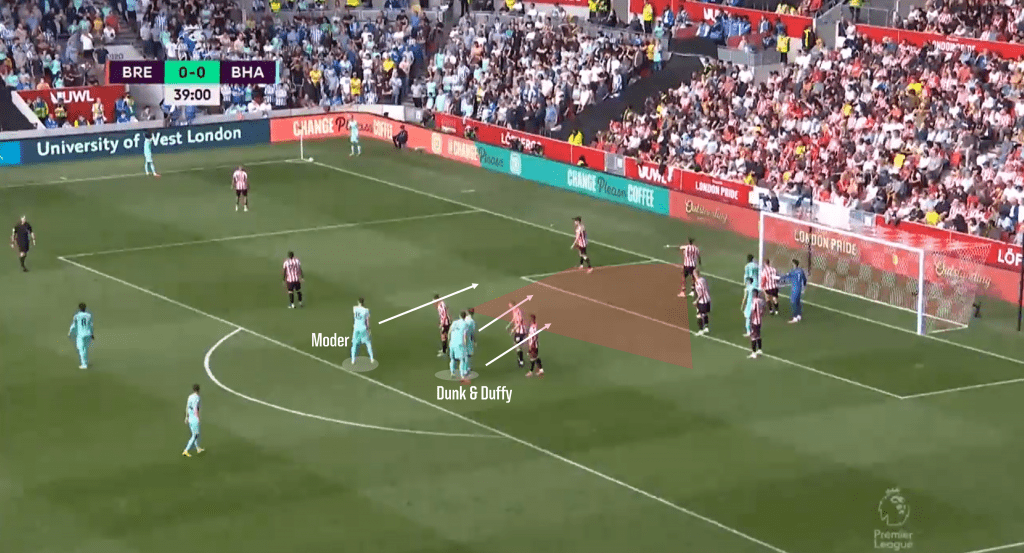
The trio split and made quick, incisive runs into that space to attack the ball.
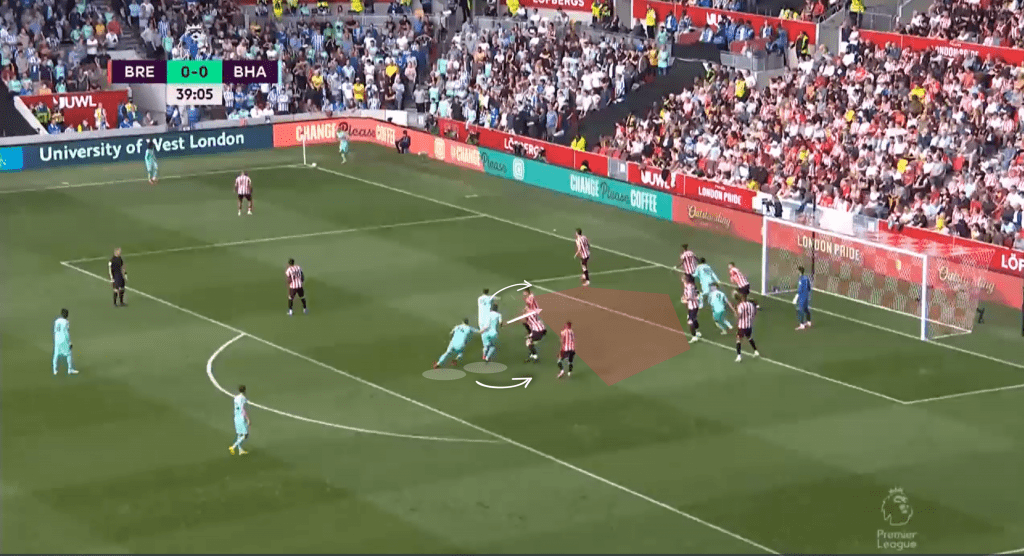
And Duffy almost gets his head on it.
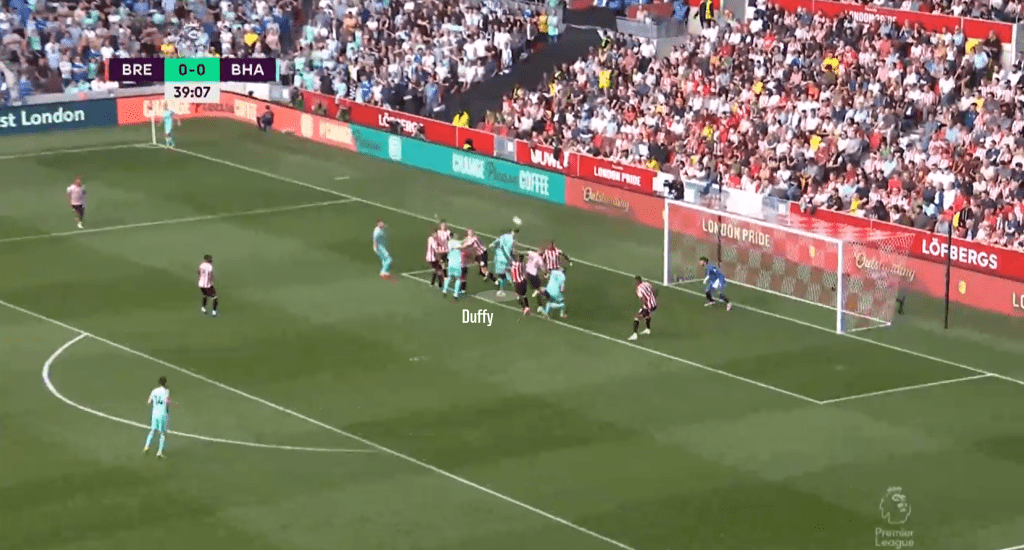
There’s not anything that intricate here. But combine good delivery with aggressive runs and height advantages and you can cause a lot of problems.
To highlight his aerial threat, since Dunk made his Premier League debut, of all defenders only Virgil van Dijk has scored more headed goals. We’ve spoken in previous editions of The Blueprint about Ben White’s weakness in the air, and he, together with partner Gabriel Magalhães will need to match Brighton’s aggression at set-pieces.
3. Arsenal Will Need to Continue to Be Brave Against the Press
On The Blueprint last week, we complimented Spurs on their proactive, pressing approach against Chelsea, particular in the first half of that game. Against Arsenal, however, it was ragged and disorganised, with Tanguy Ndombele and Dele Alli playing so advanced that it left a chasm of space for poor Pierre-Emile Højbjerg to defend. As Jamie Carragher put it on Monday Night Football when summarising Spurs’ midfield: “there’s less space on the moon!”
With that said, Arsenal still capably played through that press. The reason they’re able to do that is because in Ben White, Gabriel and Takehiro Tomiyasu, they have three defenders who are all comfortable ball-players. In possession, new-signing Tomiyasu typically tucked in to make a back three, with Kieran Tierney very advanced up the left.
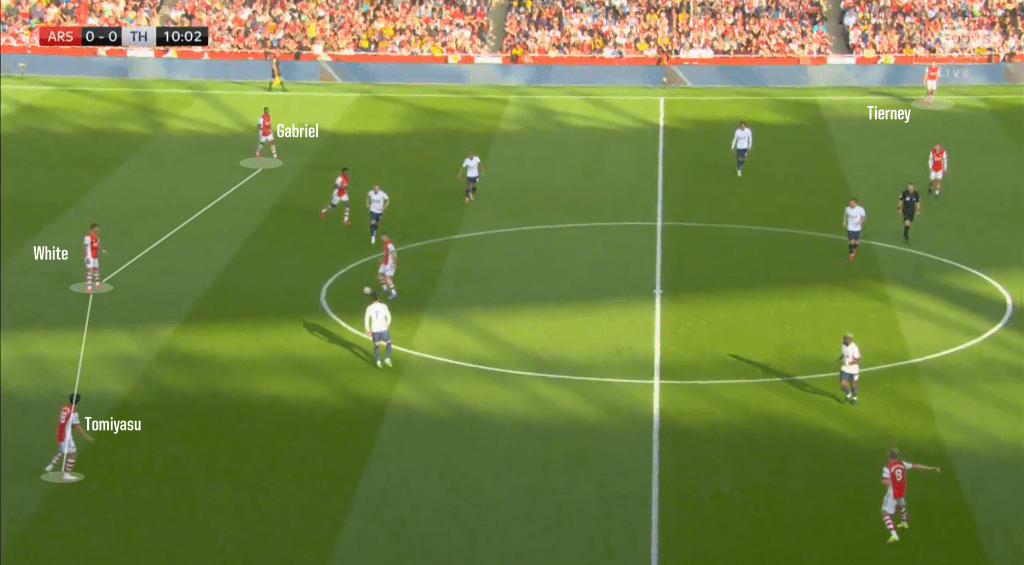
The passing range of those three “centre-backs” is therefore crucial. Each of them was able to bypass Spurs’ pressing front three to get the ball into Thomas Partey and Granit Xhaka. In doing so, they were able to drag out Ndombele or Højbjerg to create space to find Martin Ødegaard and Emile Smith Rowe in between lines.
White did this to good effect in the first five minutes.
He has the ball at the back and is faced down by Kane. Partey and Xhaka’s positioning gives Arsenal a two vs. one against Højbjerg in midfield and White is able to split Kane and Moura to find Xhaka…
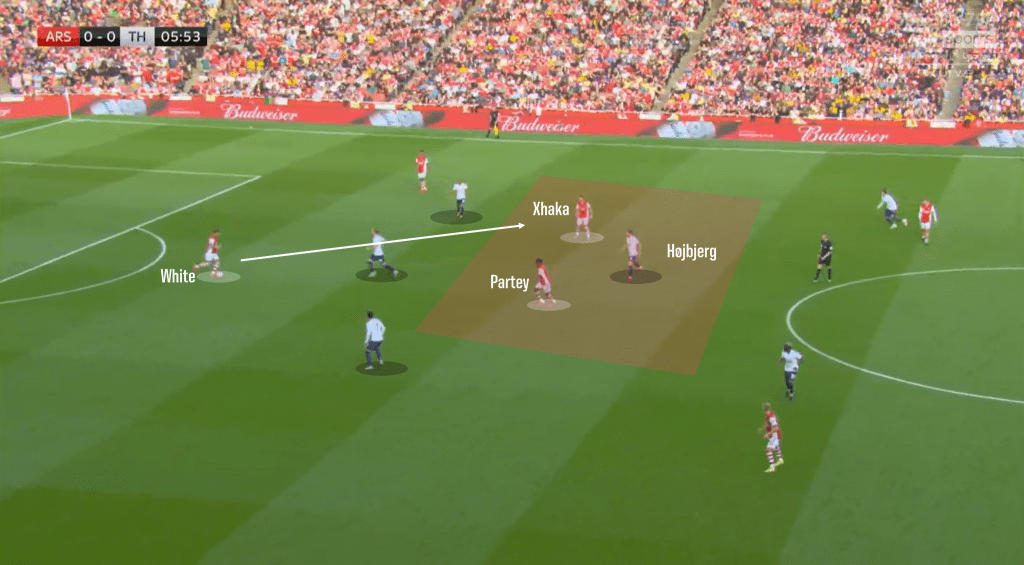
Alli rushes to pressure Xhaka, leaving a large gap behind. Xhaka feels this pressure, and flicks a pass round the corner to Smith Rowe…
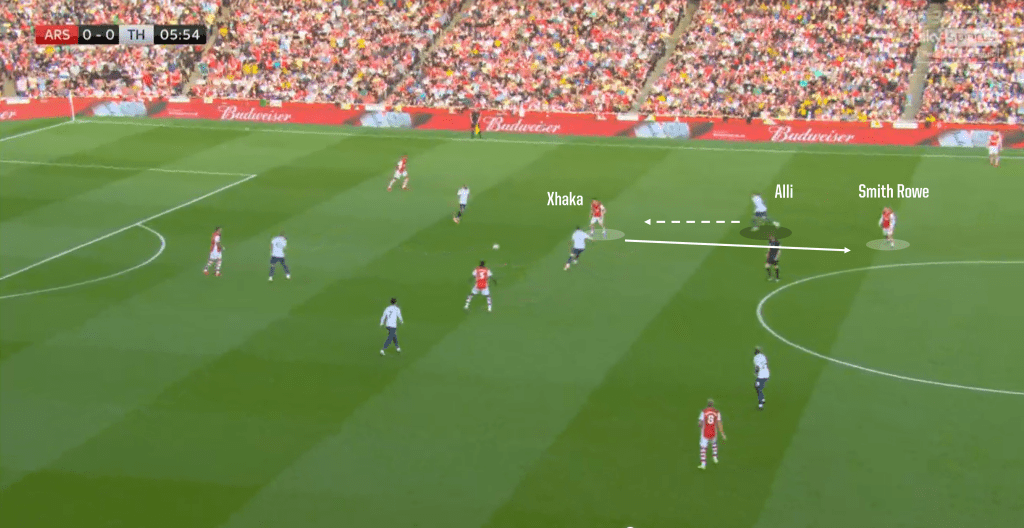
He collects, turns and feeds Tierney who is extremely advanced. Just like that Arsenal are attacking the Spurs back four.
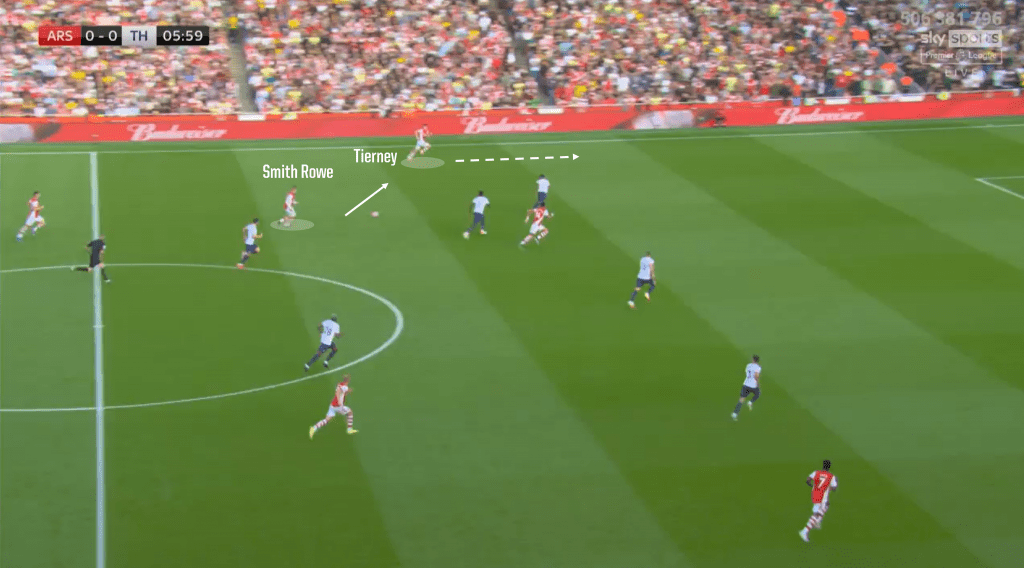
Gabriel also flashed his passing range immediately after Arsenal’s opener, finding Ødegaard in between the lines with a splitting pass that bypasses three Spurs players.
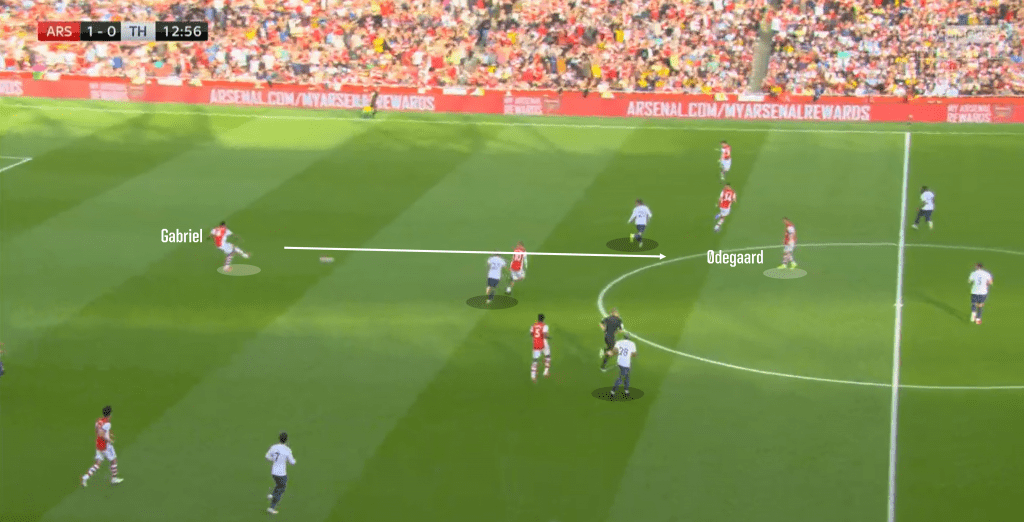
The Norwegian takes and finds Tierney again.
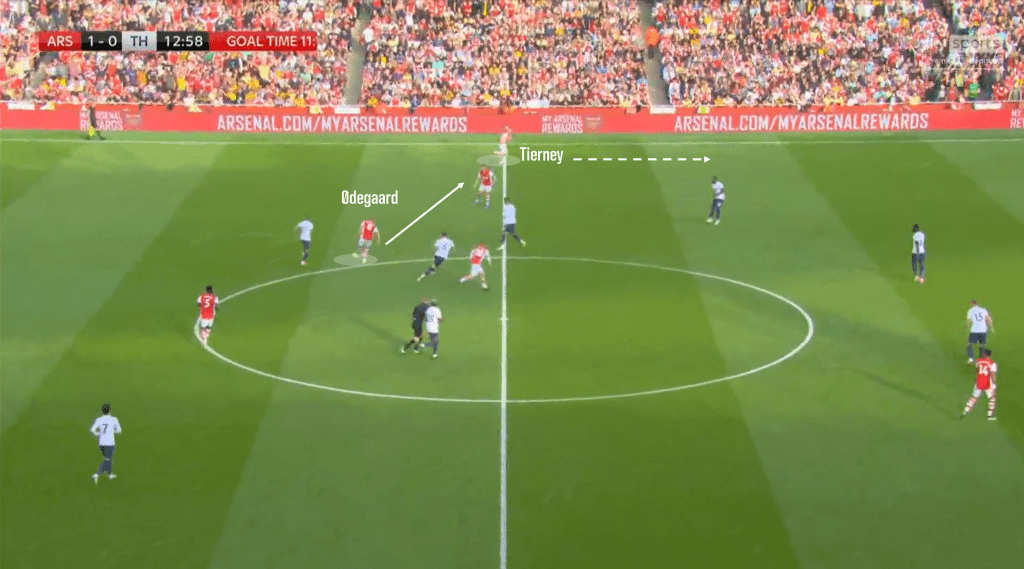
And to top it all off, Xhaka rolls pressure for the second goal. He receives a tough pass from Ramsdale with Højbjerg right on top of him.
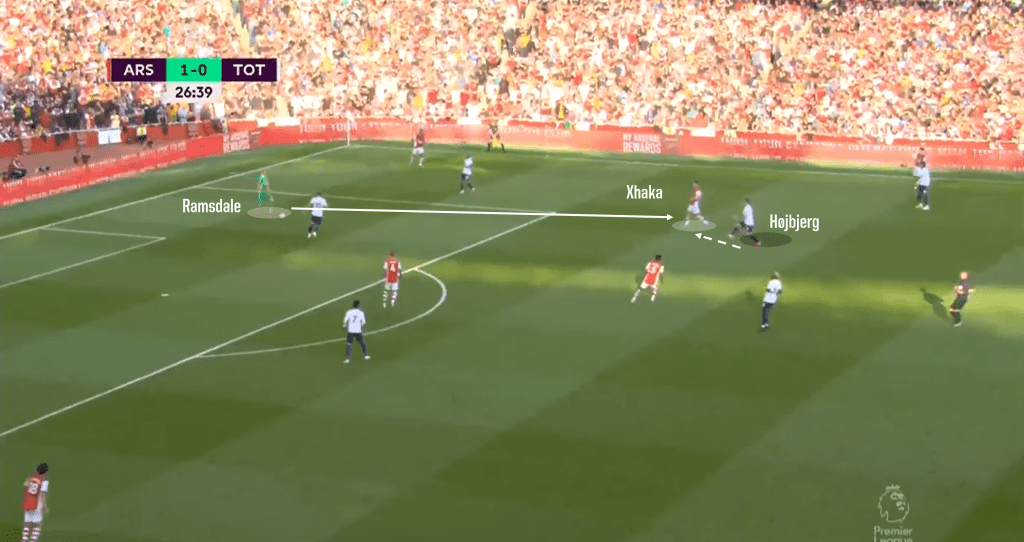
The Swiss feels the pressure of Højbjerg and rolls him with his body position…
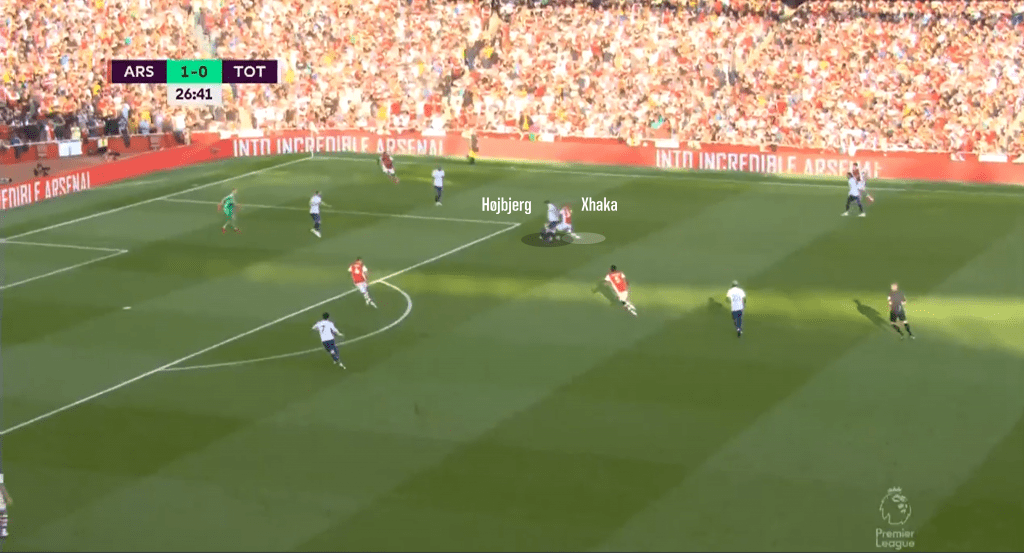
Xhaka plays the ball to Smith Rowe who’s come short. The youngster flips it to that outlet again, Tierney, who charges up the pitch, initiating the Arsenal goal.
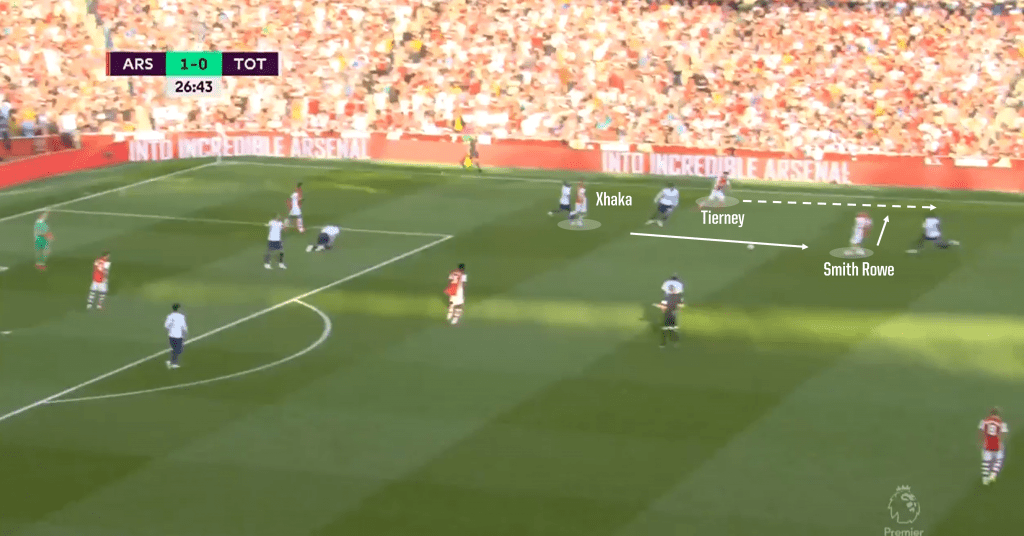
White and Gabriel especially were able to consistently play through Spurs’ press. Of all outfielders in the derby, the duo bypassed the highest average number of players per pass, cutting out an average of 2.1 Spurs players each time.
Brighton’s press is well-honed under Potter, and they’ll do a far better job on hunting down Arsenal than Nuno’s side did. The Seagulls have been pressing more than ever this season, completing 102 pressed sequences (how often a team interrupts an opponent’s possession in the final third) in the league so far, the joint-highest mark with Liverpool. And their PPDA – the number of passes they allow the opposition per defensive action – of 11.3 is the third-most intense rate in the league.
Arsenal will need to ensure their passing is sharp and crisp from the back to avoid being turned over in dangerous positions.
4. Ødegaard Finding Space in Between the Lines
Martin Ødegaard has been quietly instrumental in Arsenal’s attacking play since joining permanently in August. He’s got no assists to his name so far this season, but the advanced numbers paint a far more telling picture.
They point to a player who is key in unlocking defences. When Arsenal maintain possession for long phases of play, the midfielder is crucial in turning this maintained possession into shots on goal. Only Albert Sambi Lokonga (16) has been involved in more 10+ pass sequences that have gone on to end in a shot than Ødegaard’s 15. And in those long passing moves, Ødegaard injects much-needed threat into those passages of play. His expected goals involvement in Arsenal’s 10+ pass sequences (1.26) is higher than any other Arsenal player, demonstrating his ability to turn stale possession into dangerous opportunities for his side.
Ødegaard also has the highest secondary chances created for Arsenal – i.e the pass before the pass that leads to a shot, with nine in total. Only Mohamed Salah, Abdoulaye Doucouré and Vladimir Coufal have made more in the Premier League.
He registered another one of these for Arsenal’s opener. He found a pocket of space behind Spurs’ midfield, drove at the backline before passing to Saka who eventually squared the ball for Smith Rowe to sweep home.
Besides his involvement in the goal, Ødegaard’s positioning was crucial for helping Arsenal cut through Spurs’ press, and he frequently picked up excellent positions in between Spurs’ midfield and backline.
Immediately after Arsenal’s opening goal, Gabriel has the ball at the back and fires a ball into Ødegaard’s feet, bypassing two of Spurs’ midfield three – Alli and Ndombele – in one pass.

Højbjerg half-heartedly commits to close him down, but the Norwegian neatly turns and sets Tierney on his way, who takes on Japhet Tanganga and whips in a cross.

Again, midway through the first half, Arsenal are trying to play through the press. Ramsdale plays short to Xhaka, who looks up and implores someone to make an option for him.
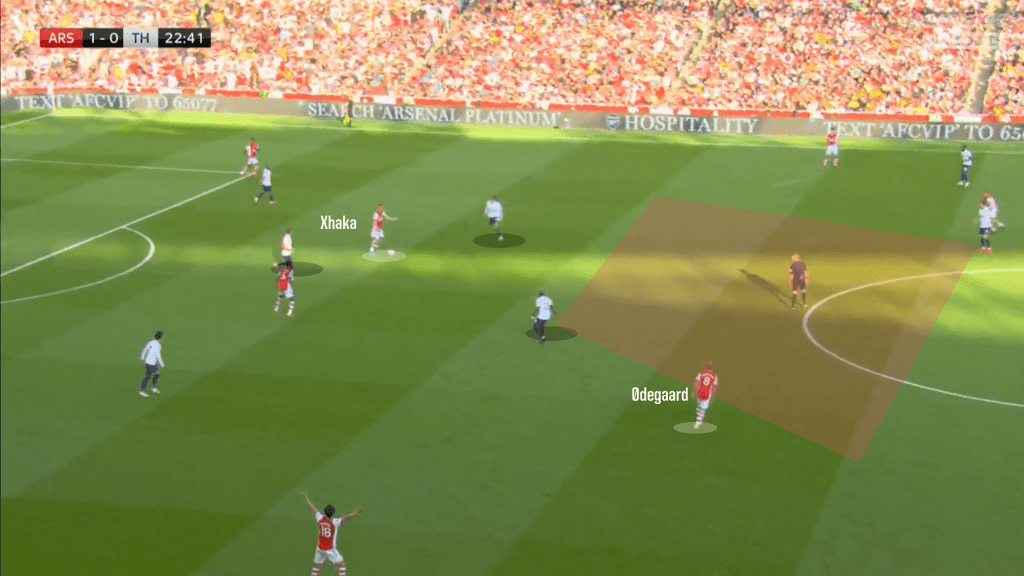
Ødegaard offers a nice angle to receive the ball behind the Spurs midfield. Ndombele does well to track back and make a tackle.
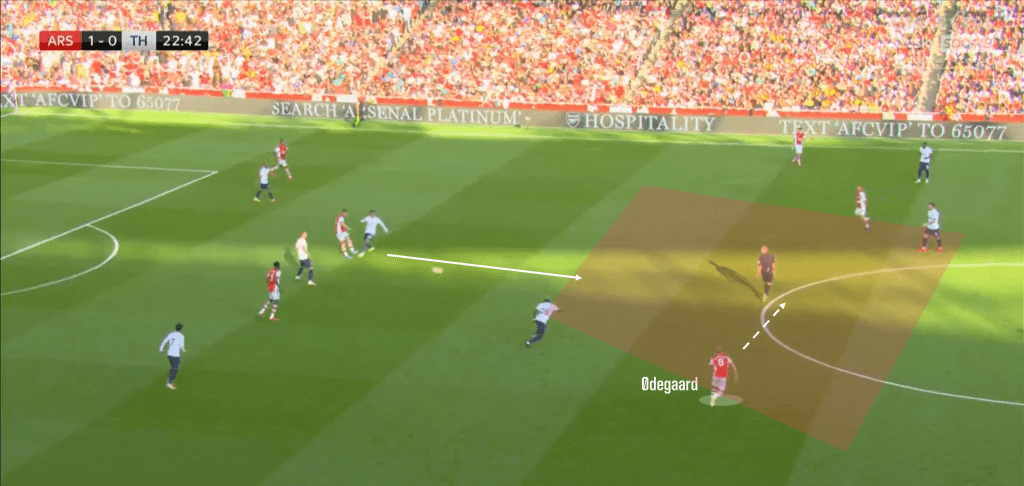
He’s intelligent enough to find space even when Arsenal are camped in the opposition half. Again, it’s Xhaka who’s on the ball and Ødegaard picks up space behind Spurs’ midfield.
Xhaka’s passing range (more on this below) enables him to fire the ball into Ødegaard, piercing through the Spurs midfield.
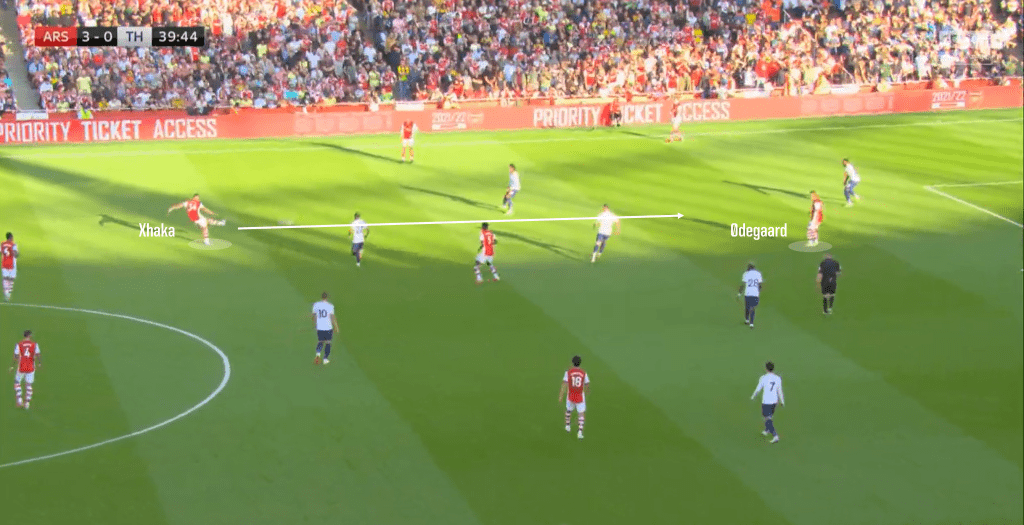
He then bounces it out first time to Tierney.
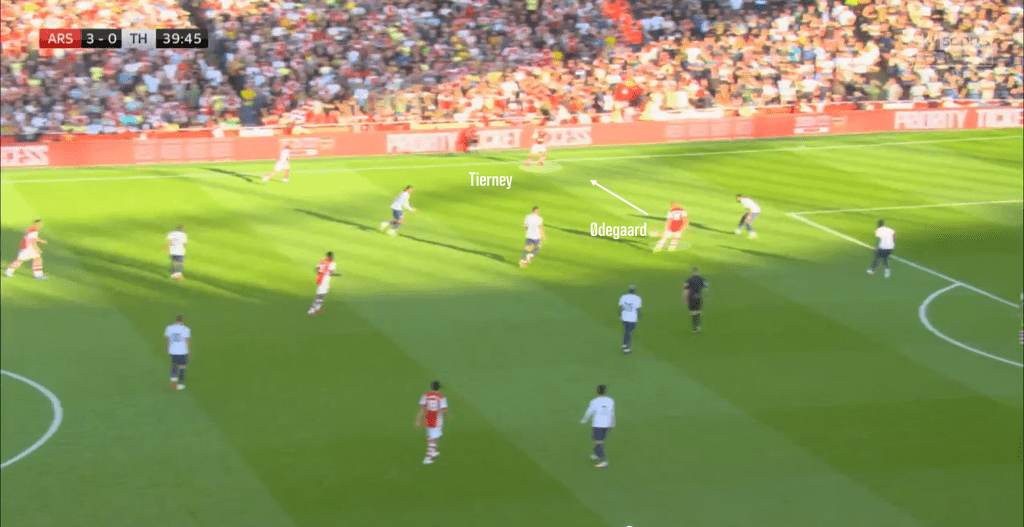
Tierney plays it back to Smith Rowe, who sees Ødegaard’s run in behind and attempts to play him in, but it’s cut out.
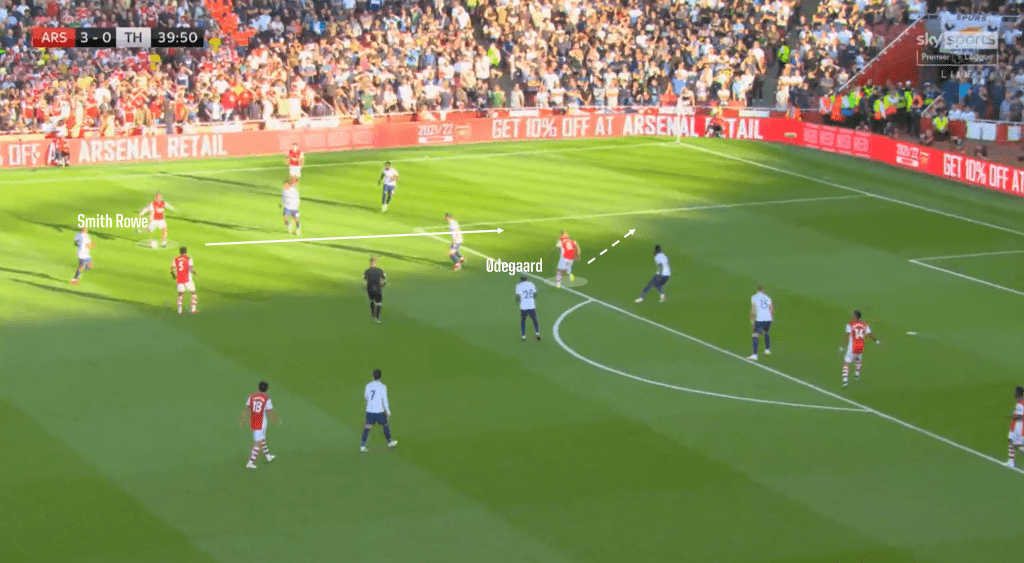
Nuno reacted to this by bringing Oliver Skipp on at half-time to sit deeper beside Højbjerg to negate the space Ødegaard was able to find behind the midfield, but the damage had been done.
Brighton will be desperate Yves Bissouma is fit enough to start in holding midfield at the weekend to attempt to smother the pockets of space in which Ødegaard operates.
5. Arsenal Will Feel the Loss of Granit Xhaka
Arsenal’s glorious North London Derby win did come at a cost, though, with the club confirming that Xhaka suffered a significant injury to his medial knee ligament. He is expected to be out for approximately three months. A divisive figure among fans during his time at the club, many will bemoan his absence, while others will no doubt shrug it off as no big deal.
In truth, a lot of what Xhaka brings to this Arsenal team is hidden by traditional metrics. He rarely gets on the scoresheet or registers an assist, so in some ways, it would be fair to ask the question – what does he actually bring to Arteta’s side?
First of all, out of possession Xhaka sits in front of Arsenal’s defence, acting as a defensive screen. He’s adept at breaking up attacks and recovering loose balls. For Arsenal, only Thomas Partey and Dani Ceballos made more ball recoveries per 90 in the Premier League last season than Xhaka’s 7.2, and the Swiss also ranked third for tackles per 90.
Once he’s won back possession, his passing range helps him to spring Arsenal attacks. Xhaka’s passing is one of his best qualities, and he’s capable of playing progressive, line-breaking balls into Arsenal’s attackers. He led the team in passes into the final third and forward passes last season on a per 90 basis, demonstrating his importance as a deep-lying passer.
Combine these two elements together and you’ve got a ball-winning player who sets the platform for his team.
We can better credit Xhaka’s influence using sequences data. Last season, he started 26 sequences that led to Arsenal having a shot, the most of any Arsenal player. Four of those lead to goals, again the most of any player for his side.
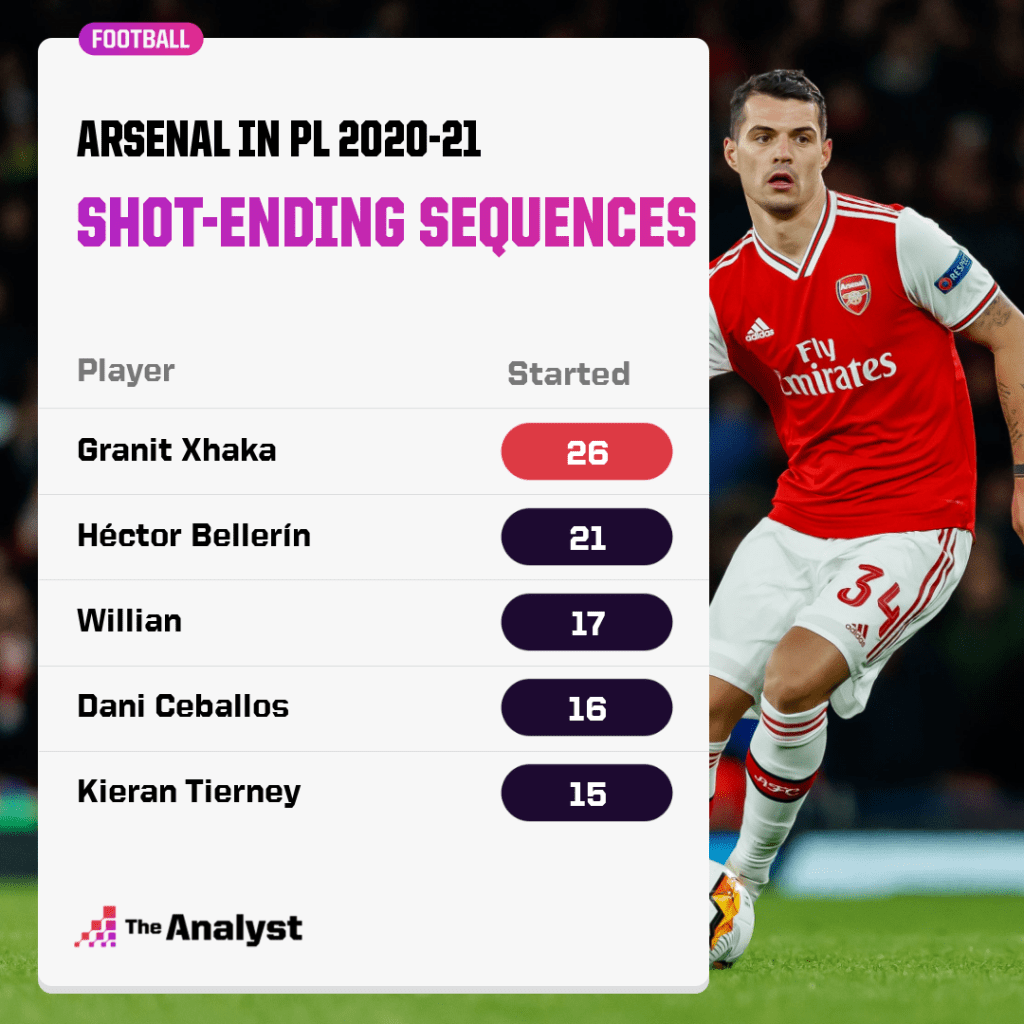
Xhaka played a lot of minutes last season, but even adjusting for that, he still ranked third for starting these shot-ending sequences (0.93 per 90).
As shown for Arsenal’s second goal above, the midfielder is also competent under pressure, able to use his body and first touch to manipulate pressers. He was Arsenal’s most pressured player last season but still retained possession well, boasting a 90% passing accuracy (third-highest on the team) and lost the ball just 9.6 times a game (fifth-best rate).
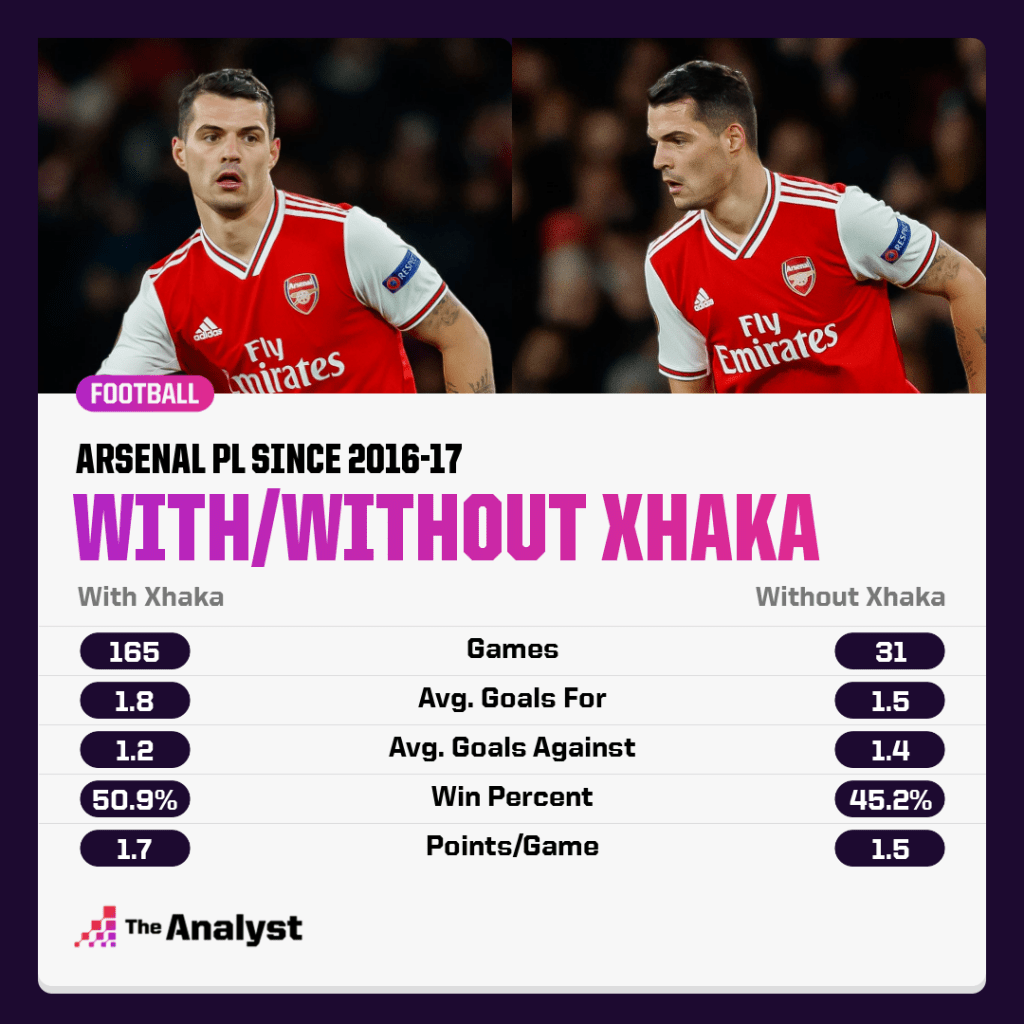
It might sound weird to some Arsenal fans, but he’ll be a loss to the side. Xhaka’s injury is an early sink or swim moment for Arsenal new boy Sambi Lokonga, who’ll look to bring courage and bravery on the ball in the centre of Arteta’s midfield.
Enjoy this? Subscribe to our newsletter to receive exclusive content.
Design by Briggs Clinard.
